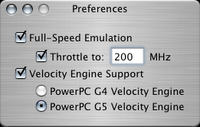It has come to my attention that a new version of Mac OS X, dubbed "Leopard" by Apple, Inc., is nearing release. Upon researching these claims, I have come to the conclusion that Leopard is the state of the art in consumer, workstation, and server operating system software and will make Apple's Mac lines the most technologically advanced in computing today.
But don't take my word for it. Let's take a look what Leopard has to offer and what its competitors sorely lack.
Back to the Future
One important feature of Leopard is real-time backups. With a new app called Time Machine, the user can voyage back through previous versions of files with a radical new graphical interface. Lost a file? Throttle your physics-defying space-time warping program and retrieve it. Rumor has it that Steve Jobs has built certain Macs with "physics processors" that may allow actual time-travel with Time Machine. For now, however, retrieving lost files and backing up your documents are easier in Leopard.
Windows, meanwhile, offers what they call "file versions," which is included on a tab at the back of the properties window. Once you find this tab, you must then read and understand all of the tiny text under the tab, then proceed to look for the version of the file you want. But what happens if you delete the file? Well, there's no properties window to open for a file that doesn't exist, so you're completely out of luck. And backing up your hard drive? There is a tool for this, but it's sadly not as good as Time Machine.
Trading Spaces
Another feature users of no other commercial operating system have is called Spaces. Spaces is, or are — depending on your dialect — extra desktops the user can devote specific windows and tasks to. For instance, instead of distracting yourself with MySpace, LiveJournal, and iChat while you write your dissertation, you can put all the windows and programs from your Internet lolling on one desktop and the apps you're using to get yourself a PhD on another.
Linux is a popular "hacker" operating system with "virtual desktops," which work the same as Spaces but are uglier and less standardized. For instance, if you load up one desktop manager for Linux, the virtual desktops feature may be stored fifty windows deep while another one may have it turned on already, stealing windows from new programs away without saying a word. Couple this with the fact that virtual desktops are abbreviated as VD and you have another win for Leopard.
Twice As Wide
For system administrators and graphic designers out there, 64-bit support in Leopard will be a huge boon. 64-bit chips can work on twice the amount of data that a 32-bit chip can, so you can get more work done in the same amount of time. Leopard supports 64-bits quite well and but can also run 32-bit programs seamlessly, allowing the user to hang onto older versions of programs and never noticing the difference. As the industry moves from 32 to 64 bits, Apple will make the transition completely transparent for its users.
Windows and Linux users have it a little harder. Windows comes in two versions, each on a different DVD. If you use Linux, watch out. You have to download the program code for the operating system, tweak it by hand, and then reinstall everything. Not for the faint of heart, eh? And there's the added risk that your program will need the same treatment if it's not ready for 64-bit. Good luck with that if you have actual work to do.
The Upshot
What does this all mean in the bottom line? You'll get more work done. You won't have Windows complaining about signed drivers and blue-screening when it doesn't get its way. You won't have to join a mailing list and kiss up to the developers of the app you need support for. In the same amount of time needed to install Vista, for instance, you can install Leopard, set it up, and download and install all the updates available for it.
With Linux, you'll be searching through your text buffer for the right command utility after the install shell dumps you to the command line. And that’s if you’re familiar with that version of Linux. There are literally hundreds of distributions, fragmenting the market and making your past experience with Linux potentially worthless if you buy something different than last time.
Windows is prettier but not much brighter: Consider making dinner, having some coffee, and maybe catching the news before Vista is ready to go. And after it does install, the first thing it'll do is evaluate your PC and tell you how slow it is. Or you could stick with Windows XP, which installs faster but has more open doors for hackers and viruses than a Grateful Dead concert has drug-smokers.
Pick your poison, or ride the Leopard.


